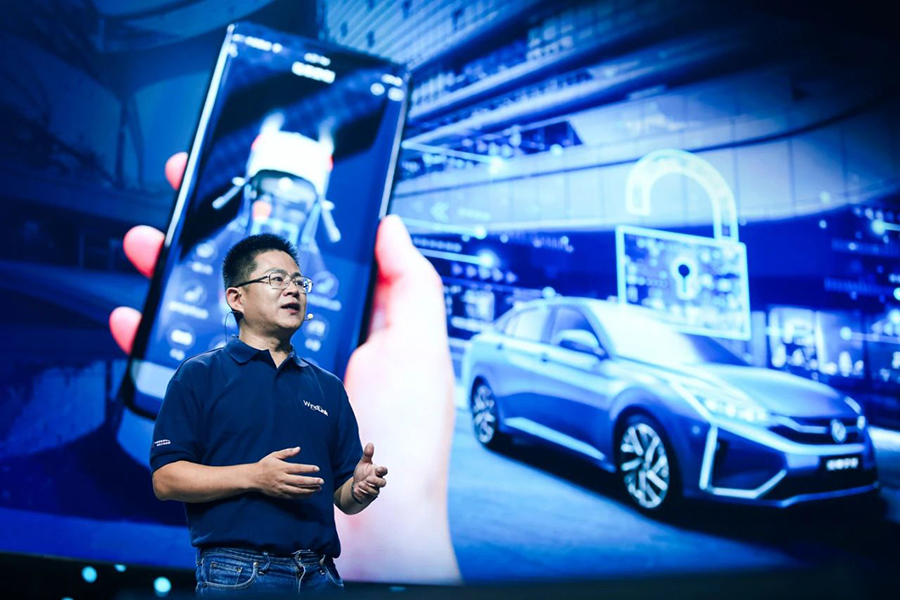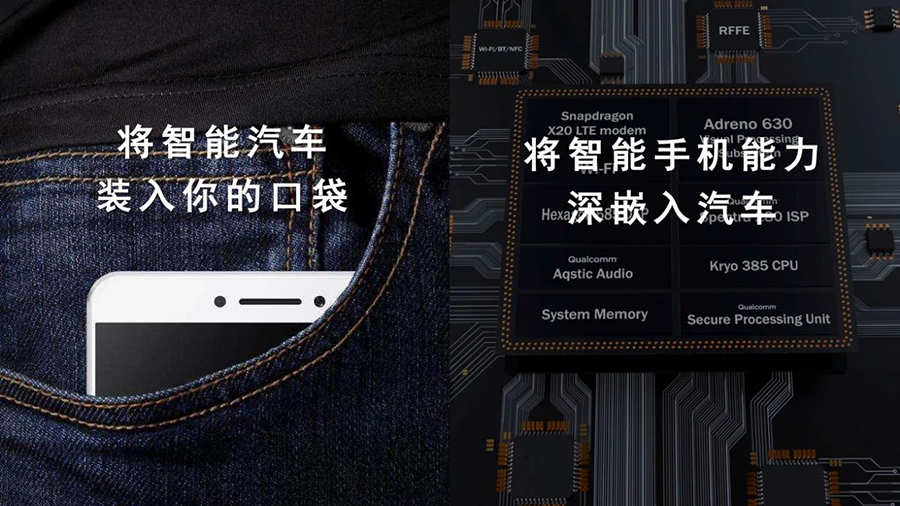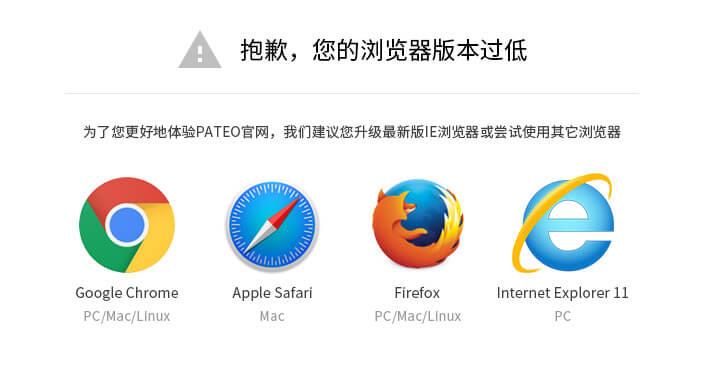As an independent third party service provider, Shanghai PATEO, a bridge between the auto enterprise and the tech giant, has successively obtained strategic investments from DFG (Dongfeng Motor Group Co., Ltd.) and Xiaomi (Xiaomi Corporation). While continuously giving prominence to its advantages in the IoV field, the company is advancing into the smart community area, and marching towards the broader battlefield of artificial intelligence (AI).
Heroes emerge in troubled times.
The century-old automotive industry is undergoing changes. Be it the transformation of the powertrain or the progress in the intelligent connectivity, they have both exerted an impact on this time-honored and huge industry.
While the changes are taking place, a “bitter winter” has unexpectedly arrived. From 2018 onwards, the growth engine of China and other major auto markets has started to “cut off”, with the global auto industry sales starting to dive; then again, in 2020, the COVID-19 epidemic befell, and the standstill of operation and production that result therefrom has been exacerbating the problems faced by the auto sector.
 Ken (Yilun) YING, Founder & Chairman of PATEO CONNECT+
Ken (Yilun) YING, Founder & Chairman of PATEO CONNECT+
“PATEO believes that winter will ultimately end, and spring will eventually come.” Ken (Yilun) YING, founder and Chairman of PATEO CONNECT+, is convinced that for PATEO, the global crisis today is only a dessert to its liking when compared with the countless challenges it has overcome throughout the 10-year journey.
The IoV, the main business of PATEO at the forefront of the automotive industry revolution, represents one of the future directions of the transformation of this hundred-year-old industry.
In the days to come, giants are bound to cast a covetous eye at this industry. Both the BAT (Baidu, Alibaba & Tencent) and the automaker are unwilling to miss this tail wind and bandwagon of business trends, and have therefore become the entrants to the market one after another, leading to a state of tangled “warfare” between these “great heroes”. Yet for all this, in this coopetition game, PATEO would rather continuously cultivate the IoV field in a deep and intensive manner as an independent third party service provider.
As an independent third party service provider, PATEO has attracted attention from more and more car companies. On Mar. 26, it secured a strategic investment of hundreds of millions of yuan from DFG (Dongfeng Motor Group Co., Ltd.); On Apr. 17, it again obtained Series B financing through a strategic investment from Xiaomi Corporation; at the same time, Ken shouted the slogan: “Sci-Tech Innovation Board (STIB), we’re coming!”
In electrification, another field undergoing changes, CATL (Contemporary Amperex Technology Co. Limited) stands out from the competition as an independent third party. PATEO would also like to be the third pole in the IoV area, which will not compete with the Internet company and the OEM, but link them up through more cooperation, to make the “cake” bigger for sharing.
Of course, to make the “cake” bigger, it should not be limited to the IoV area, PATEO’s ambition is more than that. Even during the epidemic period, PATEO still strived to open up new retail and smart community, thus increasing the growth points of the company from one to three, while either of these two areas will bring a market that’s one hundred or even one thousand times broader than that of the IoV business.
Amid the turbulence of the auto industry, whether Ken and his PATEO could stand out still remains to be seen.
Tangled “Warfare” between “Great Heroes” in IoV Field
Back in 2009, the automotive marketing veteran Ken switched to the IoV sector. “Customers felt it was a pity that my focus was on marketing instead of considering making a good product.” In Ken’s memory, that year, the 3G network was just deployed; next year, namely, in 2010, they came up with a solution for the automaker client, but the supplier could neither understand nor make it; so the automaker handed it over to PATEO, and allocated CNY 48 million for R&D. “So to speak, based on this 48 million yuan, PATEO was truly built.”
 Mobile Phone Based IoV
Mobile Phone Based IoV
In the following years, tech giants successively got in the game.
At Apple Worldwide Developers Conference (WWDC) held in Jun. 2013, Apple announced the “iOS in the Car” program, marking its officially making inroads in the automotive area. Then at Geneva Motor Show in Mar. 2014, CarPlay was officially launched.
It was probably due to the stimulation of Apple’s highlight time at the motor show that in Jun. of the same year, Android Auto made its debut in Google I/O opening keynote, and the same year also witnessed Baidu setting about building the CarLife system compatible with the IVIs based on iOS, Android, Linux or other operating systems.
At the same time, the tech companies also profoundly realized the auto enterprises’ importance, illustrated by the fact that also in 2014, Google partnered with auto companies like Audi, GM and Honda to form the Open Automotive Alliance (OAA), aimed to extend Android ecosystem to the automotive platform.
With the utterance that “It’s a disgrace to automotive industry players that passengers still use mobile phone when in the car” blurted out by Jian WANG, Chairman of Technology Steering Committee, Alibaba Group, the Group launched a new IoV initiative: setting up a joint ventures (JV) with the car company.
First came the launch of SAIC Motor’s ROEWE RX5, known as “the First Internet Car in the World”, at Hangzhou Yunqi Town on Jul. 6, 2016, followed by the establishment of a JV by Volkswagen AG, Toyota and DiDi, the partnership between Tencent and GAC and Changan, the start of cooperation between Baidu and Ford, the signing of a strategic cooperation agreement between Baidu and Geely, as well as the debut of Polestar 2, the first mass-produced vehicle model to run Android Auto — Google’s in-vehicle system.
While these “great heroes” were locked in a tangled fight in the IVI field, PATEO chose to take a different path. In 2019, the year marking the 10th anniversary of its establishment, PATEO made a decision that was difficult for many to understand – releasing the mobile phone based IoV.
In the past decade, the IoV in the traditional sense, though developing and striving to open up, had actually remained a closed system, with different manufacturers and enterprises building their own system, making the IoV more confined to and stop at the “connected car” stage, instead of evolving into a real product of the Mobile Internet (MI) Age.
Quite a few insiders held that in contrary to everyone else who was putting emphasis on the IVI, PATEO was “driving in reverse” and went back to the old path of “mobile phone mirroring”. Ken simply dismissed it with a smile, “If everyone could figure it out, it would not be an opportunity.”
Technically, the R&D of the mobile phone based IoV is not so easy. PATEO had put in nearly CNY 200 million and over 300 R&D staff before launching the mobile phone based IoV solution and successfully “putting vehicle into mobile phone”. Ken jokingly said, they were “killing themselves”.
PATEO’s goal is to “deliver the experience of the Michelin restaurant at the price of the food stall". This mobile phone based IoV solution could save RMB 800-1,600 on cost per vehicle (CPV), which means a cost reduction of RMB 0.8-1.6 billion for an auto company whose sales volume reaches 1 million units; at the same time, the vehicle is embedded in the open Internet ecosystem of the mobile phone, thus realizing 24-hour online access as well as integration and mutual complementation of mobile phone and IVI, instead of separating them from each other, only in this way could a better IoV experience be brought to the user.
Different from the traditional mirroring solutions, PATEO mobile phone based IoV solution effectively mines and brings into play the computing power of the mobile phone, thus endowing the traditional vehicle with a continuously iterative “Intelligent Brain.
Relying on the mobile phone’s computing power, in the future the capabilities of the phone screen, the front & rear cameras and the chip-level AI will be further exerted, while the deep collaboration with mobile phone manufacturers for integration from the underlying operating system level will open a larger space for imagination
On the Way to Becoming “The Third Pole”
Openness & cooperation and joint construction of ecosystem is the only way to make the “future mobility cake” bigger. However, amid the “tangled fight between great heroes”, the battle for dominance over the carving up of the “cake” has begun. Traditional giants like Volkswagen AG, Toyota and SAIC, together with Tencent and Baidu, as well as HUAWEI which has officially deployed the intelligent connectivity, are all bearing down menacingly.
Even so, PATEO CONNECT+ still prefers to participate in the game as an independent third party and cooperate rather than compete with the Internet company and the OEM. As Ken sees it, “in the extremely broad and vast IoV, only our breadth of mind and field of vision will limit us.”
But he also put it bluntly, “We cannot say PATEO has no enemies. This is contrary to the principle of commercial competition. But we’re open and independent, and are willing to make our enemy our friend, because we believe that there’s always some way to cooperate.”
This is by no means the wishful thinking of PATEO. As both the auto companies and the Internet giants have run into the bottleneck in the IoV field, they need a third party to get involved.
Some auto companies are bitterly struggling in the software field. Despite Volkswagen AG’s ambition to develop a software operating system called vw.os and build its own IoV ecosystem based on that, the reality is cruel. According to the German Manager Magazin (Manager Magazine), due to software problems, the delivery of the ID.3, an electric car produced by Volkswagen, will be unable to meet the deadline, or even delayed again and again.
On the other side, technology giants are facing the issue of opening their ecosystems. From the Alibaba-backed Banma to the more open Tencent Suixing, everyone has come out in favor of openness, but in essence big companies are always closed, even their openness is for being enclosed; it’s impossible for them to shake hands with each other, unless they can’t survive otherwise.
Just as the founder of a leading IoV company in China put it, “I’ll never assume that Tencent and Alibaba could get their ecosystems connected.” It’s true that these tech giants have outlined their own investment roadmap, as exemplified by the investment made by an Internet giant in a mobility company, but when it comes to the connection of data APIs, it’ll be difficult even for a parent company to complete it internally. Technical leaders of quite a lot companies have complained that the relevant work cannot be pushed forward even internally.
 PATEO CONNECT+ Partners
PATEO CONNECT+ Partners
Ken cited one partner as an example. After PATEO assigned 40 people and spent 6 months gaining access to its data and businesses, the partner said that both its cooperation with the OEMs and the retrieval of service information by its shareholder, an Internet giant, would be via PATEO. “When it’s impossible for ‘internal members’ to connect with and access each other, it’s only harder to connect with and access the ‘enemy’.”
This process is a test of patience. It all unexceptionally took a long time for PATEO to partner and connect with various companies, which may last up to two or three years. “Thousands of various problems might crop up. We often had to convene 70 or 80 meetings before successfully securing a partner.”
So, a better choice for the tech company to enter the IoV industry is to find a company to help them integrate the capabilities into a product and a platform, which are then copied to various car manufacturers and vehicle models, otherwise they’ll have to link up with each auto company one by one, which is time-consuming and laborious.
Take PATEO for example. For the tech company, collaboration with PATEO means they could quickly and efficiently access the fast-growing auto market with the size of three million units per year, get the sales soaring to a high level, and rapidly roll out to the user, so they’re willing to turn to PATEO.
At the same time, CATL has set an example to PATEO of “how to be an independent third party” in the new energy field. Auto companies represented by BYD have built their own battery factories, but things didn’t run smoothly when they tried to open access to other automakers. Panasonic is more like Alibaba and Tencent, with battery as only part of its vast business landscape; furthermore, its deep partnership with Tesla, while enabling the rapid increase of the volume in the early stage, has limited its production capacity output to other clients.
By relying on BMW’s demand, the battery-focused CATL stepped into the power battery field from being a supplier of cell phone batteries, has been investing heavily in this area of expertise, and has eventually grown into a “Third Pole” independent of the car companies and the tech giants.
Similar to CATL, the founding of PATEO as an independent third party service provider by Ken was also indispensable from the support of an automaker — SAIC Motor; later on, by virtue of continuous investment, the company has been persistently and deeply cultivating the IoV field, started to take the lead in the industry, and attracted attention from more and more automakers with its rapid growth nowadays. The 26th of March has witnessed a strategic investment in PATEO by DFG (Dongfeng Motor Group Co., Ltd.).
Ken said, “This strategic investment is bound to strengthen PATEO advantages. In the future, we’ll establish more cooperative partnerships with various automakers at the capital, business and business model levels, to contribute to China’s auto industry.”
At the same time, Xiaomi Corporation (Xiaomi) also took part in the game, marked by making a strategic investment in PATEO on Apr. 17. “The IoV is an important segment of future technology, and the vehicle is also the most essential intelligent terminal in future life.” Lei Jun, founder, Chairman & CEO of Xiaomi, said: “We’re very pleased to conduct an in-depth cooperation with PATEO to forge a common future.”
In spite of the fact that another new economic giant has joined in the industry, PATEO still persists in cultivating the IoV field in a deep and intensive manner as an independent third party, whose advantages have been constantly highlighted and become prominent. While building a bridge between car companies and tech giants, PATEO is also expected to become a “Third Pole” independent of the two sides, just like CATL.
For PATEO, the strategic investments from DFG and Xiaomi have opened up the room for growth and the space for imagination. In the days to come, there might be more well-known enterprises and investors joining “PATEO’s Circle of Friends”.
What’s more, according to Ken, PATEO is planning to be listed on the Science and Technology Innovation Board (STIB). By then, the capital market may witness the birth of another “CATL” in the IoV field.
Refuse to Stop at IoV, but Continue to Explore Smart Community
“The Mobile Internet has already descended to be a saline-alkali land. In the future, AI will prevail.” This is what impressed Ken the most after a 6-hour long talk with a senior executive of a well-known Chinese Internet company.
Ken, acclaimed as “Steve Jobs in China’s Automotive Industry”, demonstrates sufficient curiosity and fast learning abilities. After identifying clearly and surely the future prospect of AI, upon returning to the company, he discarded the previous OA and office systems, and replaced them with the “Feishu” platform developed by ByteDance. “If the company is still using the outfits from ancient times, how could it win battles in the future?”
PATEO has formulated the development strategy of “1+1+N”, namely, “IVI + Mobile Phone + N”, in which “N” stands for the various input & output devices, including smart home appliances such as headphone, watch, bracelet and TV, as well as all sorts of IoT (Internet of Things) devices. In the future, vehicle will become an important component of the Industrial Internet, from which PATEO will never be absent.
This happens to coincide with the development strategy of Xiaomi, which has just made a strategic investment in PATEO. Ken revealed that “in the future, PATEO will enter into a deep cooperative partnership with Xiaomi, which will enable us to move towards the IoE era at a fast pace.” Recently, some media began to reveal MIOS, the operating system of Xiaomi, bit by bit. After this investment, the two sides are expected to carry out more collaborations in the IoT field in the days to come, which is also worth looking forward to.
From small things like a company to large ones like a city, the AI and the IoE are bound to change every aspect of our life. The basis for similar people to fit together has emerged. In the future, people will be divided by their life trajectory, habitual activity and lifestyle, and the living environment will also change around people’s living habits and personality traits — This is a signal of digital transformation.
When the transformation signal sounds, a blueprint of the city of the future has already been drawn, and will soon be put in place.
In 2021, a city of the future will rise up at the base of Mount Fuji. This “Smart City”, dubbed “Woven City”, is built by Toyota centering around Connected Vehicles (CVs) and self-driving Battery Electric Vehicles (BEVs), with all products and services linked via the Internet. It’s transformed from a factory of Toyota, allowing people to live, work and study social mobility.
In the not-too-distant future, 5G will be vertically integrated into various fields. VR, robot, IoV, Industrial Internet, Municipal Internet-of-Things (IoT), smart wearables, smart home, smart meter reading, smart building… The various plots in the science fiction movies will soon become reality.
Kearney management consulting firm pointed out that if Intelligent Connected Vehicle (ICV) is linked up to a huge business ecosystem, the car will move a step further to become a node of social networking. The key differentiator is that the occupants of the vehicle are also incorporated into the ecosystem, hence the emergence of C2X (Cabin to Everything), then the commercial value will be quite different.
Smart community will be the most important segment of the ecosystem. It’s reported that the Smart Community project participated by PATEO will be put in place in core business districts like Shanghai Xintiandi and Huaihai Road in Jun. this year.
 Shanghai Xintiandi
Shanghai Xintiandi
“In the future, the vehicle will in no way be limited to the scenarios as people imagine, but will take on new forms, such as mobile real estate, mobile business, mobile tourism, mobile community employment, mobile market, and mobile finance & insurance (F&I).” Ken described the implementation and application of the IoV in the future community this way, “While reflecting on the technical issues, we should give more consideration to the business model and the solving of social pain points.”
Specifically, urban mobile business is a new business model combining vehicle with retail, taking vehicle as the carrier to create mobile shops on wheels, addressing the last 950-meter community services, and building a new retail business platform on the vehicle.
Take the current Huaihai Road for instance. If there is a mobile shop every 100 meters, it will be tantamount to 1,000 mobile real estate. For the auto enterprise, it’s a virtual vehicle vending machine, which will increase the profit of the OEM by 5%; for the street community, through the trading platform, the proportional share of income from transactions could be used as tax revenue, 8%-10% of which could be distributed to the community to boost the neighborhood’s GDP; for micro & small enterprises, the cost to rent a shop will fall; and for the government, the low-cost business startup will improve employability.
Since it’s still inappropriate to carry out large-scale offline activities in the post-pandemic era, the traditional offline channels will be weakened, the contactless new retail will flourish, and economic recovery will become a major demand and pain point of the society.
The turning point of the epidemic will facilitate the urban mobile business model, in which the Intelligent Vehicle (IV) with 24-hour access to the mobile phone based IoV will surpass the smartphone to act as an intelligent unit cell node, and take on the role as a key cell to build Smart City and Intelligent Transportation. During the epidemic, PATEO branched out into the new retail and intelligent community business areas, thus increasing the company’s growth points from one to three.
Presently, the urban mobile business is on the eve of implementation. As for the promotion of implementation of the mobile store, Ken proposed: “We hope to work with a street community for a demonstration first, starting from the lowest level street community, then gradually put it in place and push it forward step by step.”
PATEO, which has gradually grown to be a “Third Pole” by relying on the power of its IoV products, has participated in the competition in the stock market of new retail, while exploring scenario-based new models such as smart community and smart market. Meanwhile, it’s joining automakers and other partners in accelerating the reshaping of the “Vehicle + Industrial Internet + AI” business model.
 沪公网安备 31010402000676号
沪公网安备 31010402000676号 
